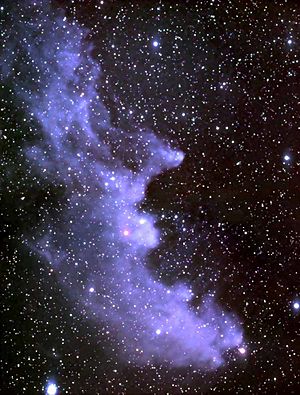IC 2118 facts for kids
IC 2118, often called the Witch Head Nebula, is a special cloud in space. It is a reflection nebula, which means it shines by reflecting light from nearby stars. This amazing cosmic cloud is found in the constellation of Eridanus, which looks like a long river in the night sky. The Witch Head Nebula is quite far away, about 900 light-years from Earth.
Contents
What is the Witch Head Nebula?
The Witch Head Nebula is a huge cloud of gas and dust in space. It gets its spooky name because its shape looks a bit like the profile of a witch's head. You can see a pointy chin and a hooked nose! This shape is created by the way the dust and gas are spread out and how light from nearby stars hits them.
Why does it glow?
Unlike some nebulae that make their own light, the Witch Head Nebula is a reflection nebula. This means it doesn't glow on its own. Instead, it acts like a giant cosmic mirror. It reflects light from a very bright, hot star nearby. This star is called Rigel, and it's one of the brightest stars in the Orion constellation. Rigel is so powerful that its light travels through space and illuminates the dust in the Witch Head Nebula, making it visible to us.
Where can we find it?
The Witch Head Nebula is located in the constellation Eridanus. Eridanus is often seen as a long, winding river in the sky. Even though the nebula is in Eridanus, it's very close to the famous constellation Orion. This is why it's lit up by Rigel, a star in Orion. If you can find Orion in the night sky, you're not far from where the Witch Head Nebula is hiding!
Understanding Reflection Nebulae
Reflection nebulae are one of the many types of nebulae in space. They are made mostly of very fine dust particles. These dust particles are excellent at scattering blue light more than red light. This is similar to why our sky looks blue during the day. Because of this scattering, reflection nebulae often appear blue in images.
How are they different?
There are other types of nebulae too. For example, emission nebulae glow because their gases are heated up by nearby stars, causing them to emit their own light. Dark nebulae are so dense that they block out light from behind them, appearing as dark patches against brighter backgrounds. The Witch Head Nebula is special because it simply reflects the light it receives.
Studying the Nebula
Scientists use powerful telescopes to study nebulae like the Witch Head. By looking at the light reflected from the dust, they can learn about what the nebula is made of. They can also figure out how dense it is and how it moves. Studying these cosmic clouds helps us understand how stars and planets form in our universe. Nebulae are often places where new stars are born, even if they are not actively forming stars themselves.
See also
 In Spanish: IC 2118 para niños
In Spanish: IC 2118 para niños


